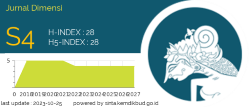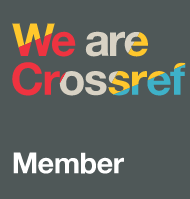PREFERENSI PENGGUNAAN BANK DIGITAL
Abstract
Keywords
Full Text:
PDFReferences
Ashraf, M. A., Maah, M. J., Yusoff, I. 2012. Bioaccumulation of Heavy Metals in Fish Species Collected From Former Tin Mining Catchment. Int. J. Environ. Res., 6(1):209-218
Damiano, S., P. Papetti, P. Manesatti. 2011. Accumulation of heavy metals to assess the health status of swordfish in a comparative analysis of Mediterranean and Atlantic areas. Marine Pollution Bulletin 6(2):1920-1925.
El-Moselhy, Kh.M., A.I. Othman, H.Abd El-Azem, M.E.A. El-Metwally. 2014. Bioaccumulation of heavy metals in some tissues of fish in the Red Sea, Egypt. Egyptian Journal of Basic and Applied Sciences Vol.1:97-105.
Frimanozi,Suci., Indra Junaidi Zakaria, Izmiarti. 2014. Komposisi dan Struktur Komunitas Ikan Kepe-Kepe (Famili Chaetodontidae) di Perairan Pantai Taman Nirwana, Kota Padang. Jurnal Biologi Universitas Andalas Vol. 3(2):092-096.
Ibemenuga and Keziah Nwamaka. 2013. Bioaccumulation and toxic effect of some heavy metals in freshwater fishes. Animal Research International Vol. 10(3):1792-1798
Dootson, B. A and J and D. Financial institutions using social media – do consumers perceive value? Int J Bank Mark. 2016;
Rinwatin, Setiyono TA. MINAT GENERASI Z DALAM BERINVESTASI TABUNG EMAS JIMEA | Jurnal Ilmiah MEA ( Manajemen , Ekonomi , dan Akuntansi ). JIMEA | J Ilm MEA (Manajemen, Ekon dan Akuntansi) [Internet]. 2021;5(2):203–11. Available from: http://journal.stiemb.ac.id/index.php/mea/article/view/1071
Singh S, Rana R. Journal of Internet Banking and Commerce STUDY OF CONSUMER PERCEPTION OF DIGITAL PAYMENT MODE. J Internet Bank Commer [Internet]. 2017;22(3). Available from: http://www.icommercecentral.com
Yanti Pujiastuti R. Journal of Applied Sciences in Accounting , Finance , and Tax TAM ( Technology Acceptance Model ) Approach to Analyze Community ’ s Interest in Using E -money. 2022;5(1):1–10.
Tan, Garry Wei-Han; Ooi K-B. Gender and age: Do they really moderate mobile tourism shopping behavior?. Telematics and Informatics. Telemat Informatics. 2018;
Utami MK. Pengaruh Kepercayaan, Kegunaan, Keamanan Terhadap Minat Menggunakan Mobile Payment Linkaja Dengan Kemudahan Sebagai Variable Mediasi. J Ilm Manaj Kesatuan. 2021;9(2):111–20.
Yang K, Lee HJ. Gender differences in using mobile data services: Utilitarian and hedonic value approaches. J Res Interact Mark. 2010;4(2):142–56.
Light J. Digital Payments Transformation From Transactions To Consumer Interactions. Europe, Africa, Middle East And Latin America. Accenture. 2013;
Bouwman. Consumer lifestyles: alternative adoption patterns for advanced mobile services. Int J Mob Commun. 2012;10(2):169– 189.
Saputri OB. Preferensi Konsumen Dalam Menggunakan Quick Response Code Indonesia Standard (QRIS) Sebagai Alat Pembayaran Digital. Journals Econ Bus Mulawarman. 2020;17(2):1–11.
Utami SS. FAKTOR-FAKTOR YANG MEMENGARUHI MINAT PENGGUNAAN E-MONEY (Studi pada Mahasiswa STIE Ahmad Dahlan Jakarta). Balance. 2017;XIV(2):29–41.
Alagoz SM, Hekimoglu H. A Study on Tam: Analysis of Customer Attitudes in Online Food Ordering System. Procedia - Soc Behav Sci [Internet]. 2012;62:1138–43. Available from: http://dx.doi.org/10.1016/j.sbspro.2012.09.195
Sahut JM. Journal of Internet Banking and Commerce. J Internet Bank Commer [Internet]. 2010;15(1):1–11. Available from: http://eprints.utm.my/8136/
Mewoh FM, Tampi JRE, Mukuan DDS. Pengaruh Digital Marketing Terhadap Keputusan Pembelian Pada Matahari Department Store Manado Town Square. J Adm Bisnis. 2019;9(1):35.
Husaeni R. Konstruksi Daya Saing Kartu E-Toll Bank Mandiri dari Perspekrif Pelanggan dengan Implementasi Model Technology Acceptance Model (TAM) di Kalangan Sseluruh Civitas Akademika Perbanas Institute. J Ris Perbank Manaj dan Akuntasi. 2017;1(1):01–10.
Phonthanukitithaworn C, Sellitto C, Fong MWL. A Comparative Study of Current and Potential Users of Mobile Payment Services. SAGE Open. 2016;6(4).
Iviane Ramosde Luna F-C. Mobile payment is not all the same: The adoption of mobile payment systems depending on the technology applied. Technol Forecast Soc Change. 146:931–44.
Zhou. Understanding the determinants of mobile pay- ment continuance usage. Ind Manag Data Syst. 2014;936–48.
Raja, J., Velmurgan SM and SA. E-Payments: Problems and Prospects. J Intern Bank Commer. 2008;
Aigbe, Princewill and Akpojaro J. Analysis of Security Issues in Electronic Payment Systems. Niger Int J Comput Appl. 2014;Vol. 108 N.
Hong, S. J., & Tam KY. Understanding the adoption of multipurpose information appliances: The case of mobile data services. Inf Syst Res. 2006;17(2):162–179.
Spangenberg, E.R., Voss, K.E. and Crowley AE. Measuring the hedonic and utilitarian dimensions of attitude: a generally applicable scale. Assoc Consum Res Provo. 1997;24:235–34.
Fiore, A.M., Jin, H., J. and Kim J. For fun and profit: hedonic value fromimage interactivity and responses toward an online store. Psychol Mark. 2005;22 No. 8:669–94.
Peng, R., Xiong, L., & Yang Z. Exploring tourist adoption of tourism mobile payment: An empirical analysis. J Theor Appl Electron Commer Res. 2012;7:21–33.
Singh, Srivastava S. International Journal of Bank Marketing Consumer preference and satisfaction of M-Wallets: a study on North Indian consumers. Int J Bank Mark. 2017;12(7):1–32.
Tan TM, Salo J, Juntunen J, Kumar A. The role of temporal focus and self-congruence on consumer preference and willingness to pay: A new scrutiny in branding strategy. Eur J Mark. 2019;53(1):37–62.
Jain P, Singhal S. Digital Wallet Adoption: A Literature Review. Int J Manag Stud. 2019;VI(1):1.
Palan, K.M., Morrow, P.C., Trapp, A. and Blackburn V. Compulsive buying behavior in college students: the mediating role of credit card misuse. J Mark Theory Pract. 2011;19(1):81–96.
Kirgiz A. Hedonism, A Consumer Disease Of The Modern Age: Gender And Hedonic Shopping In Turkey. Glob Media J. 2014;4(2):2.
O’Connor GE, Newmeyer CE, Wong NYC, Bayuk JB, Cook LA, Komarova Y, et al. Conceptualizing the multiple dimensions of consumer financial vulnerability. J Bus Res. 2019;100.
Chen HA, Marmorstein H, Tsiros M, Rao AR. When more is less: The impact of base value neglect on consumer preferences for bonus packs over price discounts. J Mark. 2012;76(4):64–77.
Setyanto RP, Sunarjo WA. Will Cashless Payment Become Consumer’S Transaction Habit in the “New Normal” Era? Trikonomika. 2021;20(1):47–53.
DOI: https://doi.org/10.33373/dms.v12i3.5847
Refbacks
- There are currently no refbacks.

This work is licensed under a Creative Commons Attribution-NonCommercial-ShareAlike 4.0 International License.











